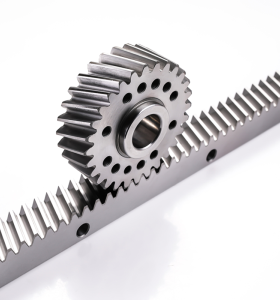|
Common materials for gears and racksGears rely on their structural dimensions and material strength to withstand external loads, which requires materials to have high strength, toughness, and wear resistance; Due to the complex shape of gears, high precision is required, and good material craftsmanship is also required. The commonly used materials are forged steel, cast steel, and cast iron. 1、 Forged steel Divided into two categories based on tooth surface hardness When HB<350, it is called a soft tooth surface When H8>350, it is called a hard tooth surface l. Tooth surface hardness HB<350 Process: Forging blank → Normalizing → Rough turning → Quenching and precision machining Common materials; 45 #, 35SiMn, 40Cr, 40CrNi, 40MnB Features: It has good comprehensive performance, high strength and hardness on the tooth surface, and good toughness on the tooth core. After heat treatment, the gear cutting accuracy can reach 8 levels Manufacturing is simple, economical, and has high productivity, with low precision requirements 2. Tooth surface hardness HB>350 When using medium carbon steel: Process: Forging blank → Normalization → Rough cutting → Quenching and tempering → Fine cutting → High and medium frequency quenching → Low temperature tempering → Gear honing or grinding agent running in, electric spark running in. Common materials: 45, 40Cr, 40CrNi Features: High tooth surface hardness HRC=48-55, high contact strength, and good wear resistance. The tooth core maintains the toughness after quenching and tempering, has good impact resistance, and high load-bearing capacity. The accuracy has decreased by half, reaching level 7 accuracy. Suitable for mass production, such as medium speed and medium load gearbox gears for automobiles, machine tools, etc.
When using low-carbon steel: Forging blank → Normalization → Rough cutting → Quenching and tempering → Fine cutting → Carburization and quenching → Low temperature tempering → Gear grinding. Reaching levels 6 and 7. Common materials; 20Cr, 20CrMnTi, 20MnB, 20CrMnTo Features: Tooth surface hardness and strong load-bearing capacity. Good core toughness and impact resistance Suitable for high-speed, heavy-duty, overload transmission or compact structural requirements, locomotive main transmission gears, aviation gears. 2、 Cast steel When the gear diameter d>400mm, the structure is complex, and forging is difficult, cast steel can be used Material ZG45.ZG55, normalized treatment. Normalization and tempering. 3、 Cast iron Strong resistance to adhesion and pitting, but poor impact and wear resistance. Suitable for stable work, low power, low speed, or large and complex shapes. It can work under the condition of oil shortage and is suitable for open transmission. 4、 Non metallic materials Made of fabric, wood, plastic, nylon, suitable for high-speed light loads. When selecting materials, consideration should be given to: The different working conditions of gears and the different forms of tooth failure are the basis for determining the calculation criteria for gear strength and selecting materials and heat treatment. For gear teeth that are prone to breakage under impact loads, materials with good toughness should be selected, and low-carbon steel carburizing and quenching can be used. For high-speed closed transmission, the tooth surface is prone to pitting corrosion, and materials with better tooth surface hardness should be selected. Medium carbon steel surface quenching can be used. When low-speed medium load, tooth breakage, pitting, and wear can all occur, materials with good comprehensive mechanical properties such as mechanical strength and tooth surface hardness should be selected, and carbon steel can be selected for quenching, tempering, and precision cutting. 4. Strive for a small variety of materials, facilitate management, and consider resource and supply conditions. When the structural dimensions require compactness and high wear resistance, alloy steel should be used. 6. Equipment and technical situation of the manufacturing unit. |






